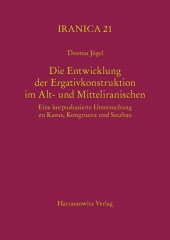 Krasnowolska, Anna & Renata Rusek-Kowalska (eds.). 2015. Studies on the Iranian World I. Before Islam. Krakow: Jagiellonian University Press.
Krasnowolska, Anna & Renata Rusek-Kowalska (eds.). 2015. Studies on the Iranian World I. Before Islam. Krakow: Jagiellonian University Press.- Maria Carmela Benvenuto, Flavia Pompeo: “The Old Persian Genetive. A Study of a Syncretic Case
- Saloumeh Gholami: “Nominal Compound Strategies in Middle Iranian Languages”
- Paolo Ognibene: “Alan Place-names in Western Europe”
- Christiane Reck: “Work in Progress: The Catalogue of the Buddhist Sogdian Fragments of the Berlin Turgan Collection”
- Arash Zeini: “Preliminary Remarks on Middle Persian <nc> in the Pahlavi Documents”
- Elham Afzalian: “Autoritäten im Mādayān–ī Hazār Dādestān”
- Iris Colditz: “Two Snake-Brothers on their Way — Mani’s Scripture as a Source of Manichaean Central Asian Parabels?”
- Seyyedeh Fatemeh Musavi: “Fictional Structure of the Middle Persian Ayādgār ī Zarērān“
- Desmond Durkin-Meisterernst: “Aspects of Hymnology in Manichaean Community in Turfan”
- Raffaella Frascarelli: “Arǝdvī Sūrā Anāhitā: Considerations on the Greek ἀρχἡ”
- Judith Josephson: “Ohrmazd’s Plan for Creation according to Book Three of the Denkard”
- Götz König: “The Pahlavi Translation of Yašt 3″
- Kianosh Rezania: “On the Old Iranian Social Space and its Relation to the Time Ordering System”
- Touraj Daryaee: “Wahrām Čōbēn the Rebel General and the Militarization of the Sasanian Empire“
- Leonardo Gregoratti: “A Tale of Two Great Kings: Artabanus and Vologaeses“
- Rika Gyselen: “Realia for Sasanian History: Mint Networks”
- Elena E. Kuzmina: “New Data on the Developement of the Indo-Iranian in the Bronze Age”
- Alireza Askari Chaversi: “In Search of the Elusive Town of Persepolis”
- Jukian Bogdani, Luca Colliva, Sven Stefano Tilia: “The Citadel of Erbil. The Italian Archaeological and Topographic Activities”
- Carlo G. Cereti, Gianfilippo Terribili, Alessandro Tilia: “Pāikūlī in its Geographical Context”
- Niccolò Manassero: “New Sealings from Old Nisa”
- Vito Messina, Jafar Mehr Kian: “The Hong-e Azhdar Parthian Rock Relief Reconsidered”
Anna Krasnowolska is a professor at the Institute of Oriental Studies, Jagiellonian University.
Renata Rusek-Kowalska is an assistant professor at the Institute of Oriental Studies, Jagiellonian University.
 Jügel, Thomas. 2015.
Jügel, Thomas. 2015.  Bergerhausen, Johannes. 2014.
Bergerhausen, Johannes. 2014.  Utas, Bo. 2013.
Utas, Bo. 2013.  Schmitt, Rüdiger. 2014.
Schmitt, Rüdiger. 2014.